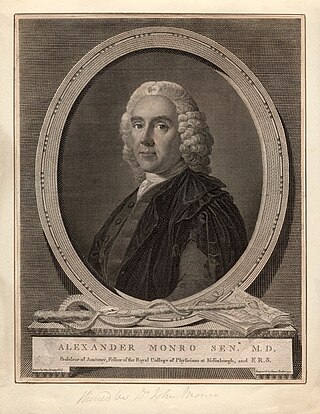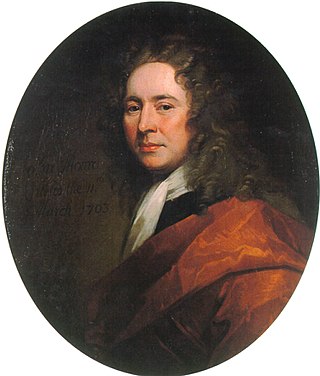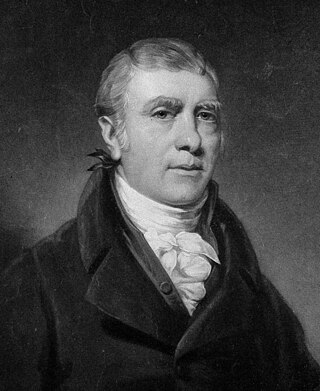
Adam Drummond of Binend (1679-1758) was a Scottish surgeon-apothecary who was appointed, jointly, as the first Professor of Anatomy at the University of Edinburgh.

Adam Drummond of Binend (1679-1758) was a Scottish surgeon-apothecary who was appointed, jointly, as the first Professor of Anatomy at the University of Edinburgh.
He was the third son of Adam Drummond (1649-1709) of Megginch, 9th of Lennoch, a Commissioner to the Scottish Parliament and a Privy Councillor of Scotland. [1] His father, a prominent Scottish lawyer and politician, was appointed in 1692 as one of the commissioners into the enquiry into the massacre of Glencoe. [2] His elder brother John Drummond 10th of Lennoch and 3rd of Megginch was Member of Parliament for Perthshire. Adam Drummond was born on the family estate at Megginch in Perthshire and went to the local school in Errol before matriculating at St. Andrews University at the age of sixteen. [2] Three years later he became surgical apprentice to Thomas Edgar who had been Deacon of the Incorporation of Surgeons of Edinburgh from 1685 to 1687. On completion of his apprenticeship he went, as was the custom of the day, for further education at a continental University. En route to the continent he took a course of anatomy in London from a fellow Scot Dr Robert Erskine of Alva, before further studies at the University of Leyden.
On his return to Edinburgh, Drummond was admitted to the Incorporation of Surgeons in 1707 [3] and established a practice as a surgeon-apothecary in the Lawnmarket in Edinburgh. He was appointed as the joint Professor of Anatomy to the Town’s College (which became the University of Edinburgh in 1708) to join Robert Eliot, who had been appointed in 1705, was the first to hold that post and was the first Professor of Anatomy in Britain. In 1720 Drummond resigned "owing to the state of his health and his business", [4] although it is likely that this was as a result of pressure from John Monro, who wished to advance the interests of his son Alexander. One week later the University appointed Alexander Monro primus as his successor, paving the way for the famous dynasty of Anatomy professors. [5]
Drummond’s practice as a surgeon-apothecary flourished and he dispensed remedies prescribed by the most eminent physicians of the day. This successful practice attracted many apprentices.
Drummond had been librarian to the Incorporation of Surgeons from 1746 and was Deacon (President) of the Incorporation between 1748 and 1750. [3]

In the 1745 Jacobite uprising the Jacobite army under Prince Charles Edwart Stuart defeated a Government army under the command of General Sir John Cope at the Battle of Prestonpans. Among the surgeons from Edinburgh who came to attend the wounded was Colin Simpson, one of Drummond’s apprentices, whose loyalty to the Government was such that he was entrusted to secretly deliver 400 guineas to Drummond’s nephew, Captain Adam Drummond, paymaster to the 47th Regiment of Foot, who had been captured after Prestonpans and was being held prisoner at Queensberry House in Edinburgh. [2]
He married Margaret Spittall in 1710. Their daughter Elizabeth married James Stuart who served three terms of office as Lord Provost of Edinburgh. Margaret was an ancestor of Sir James Spittal, Lord Provost in the 19th century.
Drummond bought a house and estate at Binend near Burntisland in Fife. [2] Later known as Binnend the estate lies near Burntisland but its associated village went into decline from the 1890s and was fully abandoned in 1954. [6]
He died in November 1758 and was buried in Greyfriars Kirkyard, Edinburgh. [1]

James Drummond, 4th Earl of Perth, KT, PC was a Scottish peer and politician.

Alexander Monro was a Scottish surgeon and anatomist. His father, the surgeon John Monro, had been a prime mover in the foundation of the Edinburgh Medical School and had arranged Alexander's education in the hope that his son might become the first Professor of Anatomy in the new university medical school.

General Alexander Gordon, 2nd Duke of Gordon, styled Earl of Enzie until 1684 and the Marquess of Huntly from 1684 to 1716, was a Scottish Jacobite peer.

Clan Drummond is a Highland Scottish clan. The surname is rendered "Druimeanach" in modern Scottish Gaelic.

Alexander Monro of Craiglockhart and Cockburn was a Scottish anatomist, physician and medical educator. He is typically known as Alexander Monro Secundus to distinguish him as the second of three generations of physicians of the same name. His students included the naval physician and abolitionist Thomas Trotter. Monro was from the distinguished Monro of Auchenbowie family. His major achievements included, describing the lymphatic system, providing the most detailed elucidation of the musculo-skeletal system to date and introducing clinical medicine into the curriculum. He is known for the Monro–Kellie doctrine on intracranial pressure, a hypothesis developed by Monro and his former pupil George Kellie, who worked as a surgeon in the port of Leith.

John Monro of Bearcrofts (1670–1740) was a Scottish surgeon who was the progenitor of the Monro dynasty of anatomists in Edinburgh. He is credited with conceiving and playing a major role in founding the University of Edinburgh Medical School. He served as Deacon (President) of the Incorporation of Surgeons of Edinburgh.
Adam Drummond, 11th of Lennoch and 4th of Megginch, was a Scottish merchant, banker and politician who sat in the House of Commons between 1761 and 1786.

Greyfriars Kirkyard is the graveyard surrounding Greyfriars Kirk in Edinburgh, Scotland. It is located at the southern edge of the Old Town, adjacent to George Heriot's School. Burials have been taking place since the late 16th century, and a number of notable Edinburgh residents are interred at Greyfriars. The Kirkyard is operated by City of Edinburgh Council in liaison with a charitable trust, which is linked to but separate from the church. The Kirkyard and its monuments are protected as a category A listed building.

The Munros of Auchinbowie are a distinguished branch of the Scottish, highland Clan Munro. From this family three Professors of Anatomy at the University of Edinburgh, Scotland were produced, as well as several other doctors and military officers.

John Barclay was a Scottish comparative anatomist, extramural teacher in anatomy, and director of the Highland Society of Scotland.

John Rattray was an Edinburgh surgeon who served as surgeon to Prince Charles Edward Stuart during the Jacobite rising of 1745. He was a proficient archer, winning the Edinburgh Arrow on two occasions, however it is for his golfing achievements that he is principally remembered. A skilful golfer, Rattray won the first competition organised by the Company of Gentleman Golfers to become the 'Captain of Goff' for a year. In this capacity he signed the first ever Rules of Golf.
John Drummond, 10th of Lennoch and 3rd of Megginch Castle in Perthshire, was a Scottish Member of Parliament.

James Borthwick of Stow (1615-1675) was a Scottish surgeon who was the first teacher of anatomy in the Incorporation of Surgeons and Barbers of Edinburgh. He was Deacon (President) of the Incorporation on two occasions and a member of the Scottish Parliament. Borthwick was largely responsible for the formal creation of the surgeon-apothecary in Edinburgh.

William Borthwick of Pilmuir (1641-1689) was a Scottish surgeon who, having studied at Leiden and Padua, was the first to bring an international perspective to the Incorporation of Surgeons of Edinburgh. He served as Deacon (President) of the Incorporation from 1675-1677 and again from 1681-1683.
Alexander Monteith of Auldcathie (1660–1713) was an Edinburgh surgeon, who in his three terms as deacon (president) of the Incorporation of Surgeons of Edinburgh, presided over some of the most important changes in its history. These included obtaining the rights to perform anatomical dissection on the bodies of prisoners dying in jail, the granting of a royal charter by William and Mary in 1695, and the construction of the original Surgeons' Hall, the first permanent home of the Edinburgh Surgeons.
Charles Stuart of Dunearn FRSE (1745–1826) was a Scottish minister who went on to co-found the Royal Society of Edinburgh and to be President of the Royal College of Physicians of Edinburgh.
Extramural medical education in Edinburgh began over 200 years before the university medical faculty was founded in 1726 and extramural teaching continued thereafter for a further 200 years. Extramural is academic education which is conducted outside a university. In the early 16th century it was under the auspices of the Incorporation of Surgeons of Edinburgh (RCSEd) and continued after the Faculty of Medicine was established by the University of Edinburgh in 1726. Throughout the late 18th and 19th centuries the demand for extramural medical teaching increased as Edinburgh's reputation as a centre for medical education grew. Instruction was carried out by individual teachers, by groups of teachers and, by the end of the 19th century, by private medical schools in the city. Together these comprised the Edinburgh Extramural School of Medicine. From 1896 many of the schools were incorporated into the Medical School of the Royal Colleges of Edinburgh under the aegis of the RCSEd and the Royal College of Physicians of Edinburgh (RCPE) and based at Surgeons' Hall. Extramural undergraduate medical education in Edinburgh stopped in 1948 with the closure of the Royal Colleges' Medical School following the Goodenough Report which recommended that all undergraduate medical education in the UK should be carried out by universities.
George Lauder, was an Edinburgh surgeon who was deacon (president) of the Incorporation of Surgeons of Edinburgh in 1744. During the Jacobite rising of 1745-46 he cared for the wounded after the Battle of Prestonpans, acted as surgeon with the Jacobite army on its march into England and retreat to Scotland, where he cared for wounded after the Battle of Falkirk.
Colin Drummond was a Scottish merchant and politician who lived in Quebec, Canada.
John Drummond, 12th of Lennoch, 5th of Megginch, was a Scottish politician who served as MP for Shaftesbury.